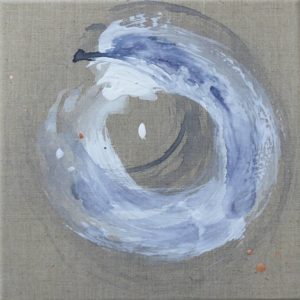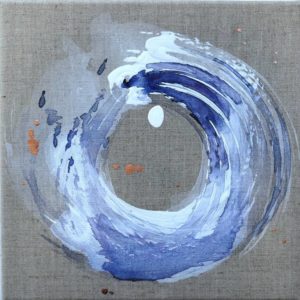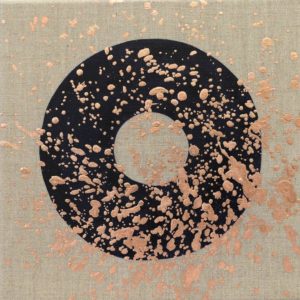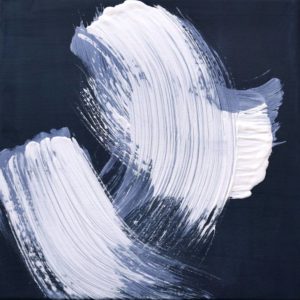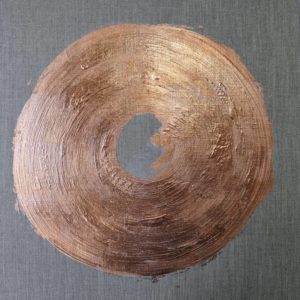The Others
 Meet the Others: Caroline Banks
Meet the Others: Caroline Banks
The Game Changers. The Rule Breakers. The Innovators. Discover some of the fantastic emerging talent showcasing their work at The Other Art Fair.
Tell us about who you are and what you do. What is your background?
I’m mainly painting at the moment, working with paper and canvas, both stretched and un-stretched.
My concern over the past 8 years or so has been research into the nature of memory and the transference of energy through gesture. I have developed these themes through a vocabulary that includes the circle as well as certain shapes that form a personal calligraphic language over time.
My background from art school is in mixed-media, officially textiles, and I worked a lot three-dimensionally with plastic, wire and leatherette, creating immersive environments as well as hangings. My career path was fairly straightforward, exhibiting and working mainly in design for fashion and interiors but I reached a point of crisis where, if I thought my life was just going to be a comfortable London one I was going to go mad. So, after a period of self-examination, in 2001 I left my job as a company director, rented out my flat and moved to India, ostensibly for 12 months. It turned out to be one of the best decisions of my life and one of the most challenging and rewarding experiences. I came back to London after 6 ½ years with a very different outlook on life and to the beginning of the global recession.
If you could describe your work in 3 words, what would they be?
Expressive, gestural, contemplative
https://www.instagram.com/p/CCSrkubjrE7/
How did you first get interested in your mediums and what draws you to them specifically?
A lot of it has to do with memory as well as the formal qualities of materials.
Gesso has a soft chalkiness that reminds me of the hand-embroidered linen bedsheets I’ve inherited from my mother’s side of the family and still use. That sense of continuity, of rootedness moves me. Sized linen canvas is one of my favourite grounds partly as I like the texture but also as it’s a wonderful mid-tone with the gesso and ink. I have use ink for decades now: initially writing ink but that had colour fastness issues so I now use lightfast acrylic inks. You can’t make any mistakes with your brushstrokes with ink – once that mark is made you can’t take it back, a bit like life really. The metal gilding began when I wanted to add an element of preciousness to a piece. I sometimes call the gilding little splashes of joy – the lovely by-products of a gesture, a moment remembered, something to treasure.
People have commented that the combination of materials symbolises the four elements: natural linen – earth; gesso – air; ink – water and gilding – fire but that’s not a conscious thing.
Can you walk us through your process? How do you know when an artwork finished?
Everything I do begins with observational drawing which may surprise given that most of my current work is abstract. I also draw dance, movement, anything really, developing and refining my hand-eye coordination. I then make lots of studies (and I mean lots!) testing different ideas out in terms of composition, content, colour, formal tonal relationships, all explorations of different routes and possibilities. It’s very much a “what if?” kind of time for me.
I then edit down to a small number of studies then make larger ones which are sometimes on canvas or canvas board. If I’m working towards a show such as The Other Art Fair or a commission, I’ll then make larger pieces which so far have been anything from 100 x 100cm upwards. Sometimes I’ll do a 1:1 scale study on paper just to check everything but some of my best pieces are when I just go for it. I love working big as can bring my whole body into the process which gives me more control over the fluidity of the mark-making. I say more control but perhaps more accurately a greater sense of generosity. I paint on the floor which adds a performative aspect to the process.
The actual painting is very fast – I’ll have got myself into a state of calm and focus to make what should look like effortless brush strokes. Often I may just paint for less than a minute and then have to wait 24 hours for that layer to dry. That gives me time to reflect on the piece and the next stage. It requires focus and a lot of practice to get the mark-making to look effortless and it doesn’t always go to plan. A lot ends up in the compost bin or is recycled.
When do I know it’s finished? There is a point reached when anything else added will detract, a sense of balance achieved. It just happens and can be difficult to recognise. I often leave a piece then come back to it if I’m not sure.
https://www.instagram.com/p/CDL9QVrlOtJ/
Has being in isolation affected your artwork practice in any way?
I’ve found it really challenging in many ways: One positive is that I returned to life drawing which I hadn’t given myself time to do for ages. I’ve also learnt new online skills and have made connections and collaborated with other artists for the V-Art Show which was a wonderful project during lock-down. I’ve also had time to think more deeply about my practice and reassess my purpose as an artist. I think my main negative was not being able to use my studio – I’ve found being in a smaller and domestic space has been quite a constraint on developing some of my ideas so have been producing a lot of small studies to expand on when I return to the studio.
What is the best advice given to you as an artist?
Surround yourself with a supportive community. That’s one of the things I love about the The Other Art Fair experience and is something I’ve really benefited from, especially during lock-down.
Shop artwork by Caroline and other trailblazing artists at The Other Art Fair’s Online Studios.
Introducing The Other Art Fair Online Studios, a new online platform offering art lovers around the world access to over 800 Fair artists. The Online Studios will keep our community feeling inspired, engaged, and continue to spread joy through art.



